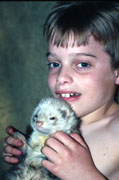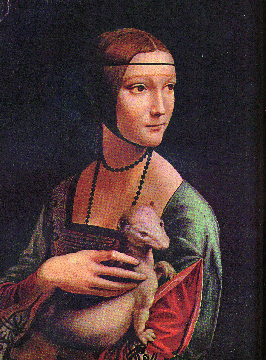 
New York Review of Books
To the Editors: Leonardo's charming "Portrait of a Lady with an Ermine," now on display at the National Gallery, has been widely publicized this fall, most recently by Gary Wills ("Goodbye, Columbus," Nov. 21, 1991). Mr. Wills adds a learned note giving one of the portrait's traditional glosses and a new one of his own. By tradition, the ermine is supposed to be a visual pun on the resemblance of the lady's name, Cecilia Gallerani, to the Greek galeé (weasel, marten-cat, or ferret). By tradition, the portrait was also a nod to Lodovico Sforza, Leonardo's patron, whose emblem was the ermine. Since Cecilia was Lodovico's mistress, her caresses for the ermine were really intended for him. Wills suggests a new, third visual pun: that "the exquisite treatment of the ermine's fur ... takes on more point if we remember that ermine was customarily used in painter's brushes." As a member of the same family, I can assure you that the animal portrayed is not an ermine. An ermine is a small weasel species, mustela erminea, in winter coat. It is brown in summer, and snow-white in winter, except for the black tip of its tail; it has never been domesticated; and its range is in the far north, not Italy. It is tiny and skinny, about ten inches long, head and body, an inch or so in diameter, and rarely more than a pound in weight. If you hold one in your arms, like the lady in the portrait, you are likely to get bitten. The "ermine" in the portrait is too large and tame, and the wrong color, to fit this description. It is cream-colored, holdable, and pettable. Relative to the lady, it is as long as, and almost as robust as, the small cat depicted in Leonardo's "Madonna with Cat." It would have about fourteen inches of head and body, and perhaps three or four pounds in weight. These features say the animal is probably a good-sized male European Ferret, mustela putorius furo, very much like me. Ferrets are lovable and holdable, having been domesticated for many centuries; males can be as large as the one in the portrait; and they come in cream. Such distinctions were not trifling to Leonardo and should not be trifling to art historians. Leonardo studied human and animal anatomy in painstaking detail. He wanted to get his subjects exactly right, and from the core, not just on the surface. Leonardo probably never saw a live ermine, but he must surely have known the colors of ermine from pelts used for costumes -- and chosen not to use them in the portrait. As a painter who made his own brushes, he must have been especially aware of the differences between one mustelid species and another, since only three species have a pelage long enough, and springy enough, to make top-grade brushes. And he certainly knew that weasels were small: witness the fable he wrote out in the Codex Atlanticus, fol. 67, v-d, in which a weasel, stalking a mouse, is "suddenly seized and devoured at once" by a cat (who rewarded the grateful mouse by eating him also). No cat could make such short work of the brawny creature in the portrait. Nor is the animal an ermine of the mind, like the comical little creature in William Segar's "Ermine Portrait" of Queen Elizabeth a century later. Segar's "ermine" was closer to the right size and color than Leonardo's, but it was neatly and heraldically covered with black spots like no real ermine the world has ever seen. Like Leonardo, Segar had probably never seen a live ermine, but he clearly intended to represent one. There is no trace of such an intent in the Leonardo portrait. Why tradition persists in calling the animal an ermine is a mystery. Does this make any difference
for the learned glosses? Not for the pun on galeé, since galeé
also can mean ferret. But the Sforza tribute (which Mr. Wills does not
mention) would be either lost or turned to a taunt. Cecilia would be bestowing
her favors not on Lodovico, but on an impostor, a big, shifty-looking male
ferret playing the part of an ermine. As for the pun on paintbrushes, it
would better fit another cousin, the Siberian weasel, mustela sibirica,
than either the ermine or the ferret, both of whose fur is too short and
soft for paintbrushes. The Siberian weasel is yellow-brown in summer, bright
yellow ochre in winter. Leonardo probably used its tail fur for paintbrushes,
as painters still do today, under the name of Kolinsky mink. But it is
a weasel, not a mink, and too skinny and wild, and the wrong color, to
be the animal in the portrait. Art critics prize authenticity but don't
always get it right in the first five centuries. Take it from me. A new
title, "Portrait of a Lady with a Ferret," would get the next five centuries
off to a much better start.
Yours,
|
|
Go Back |
